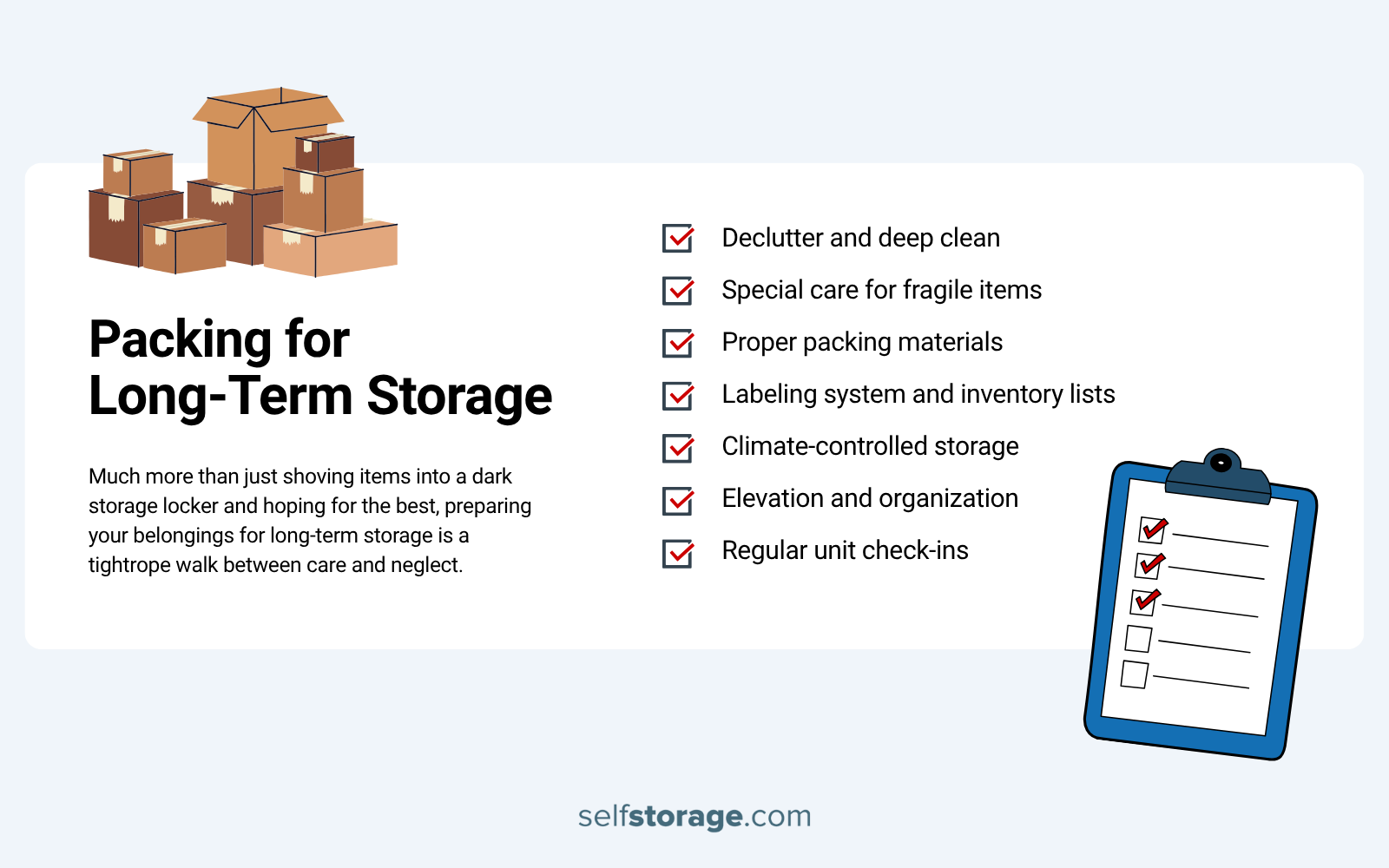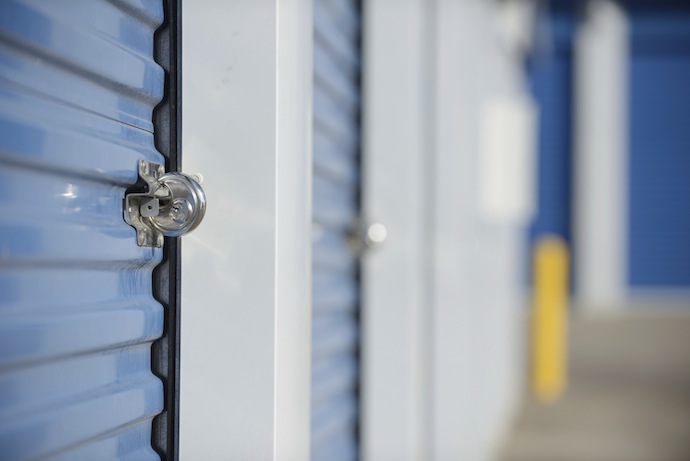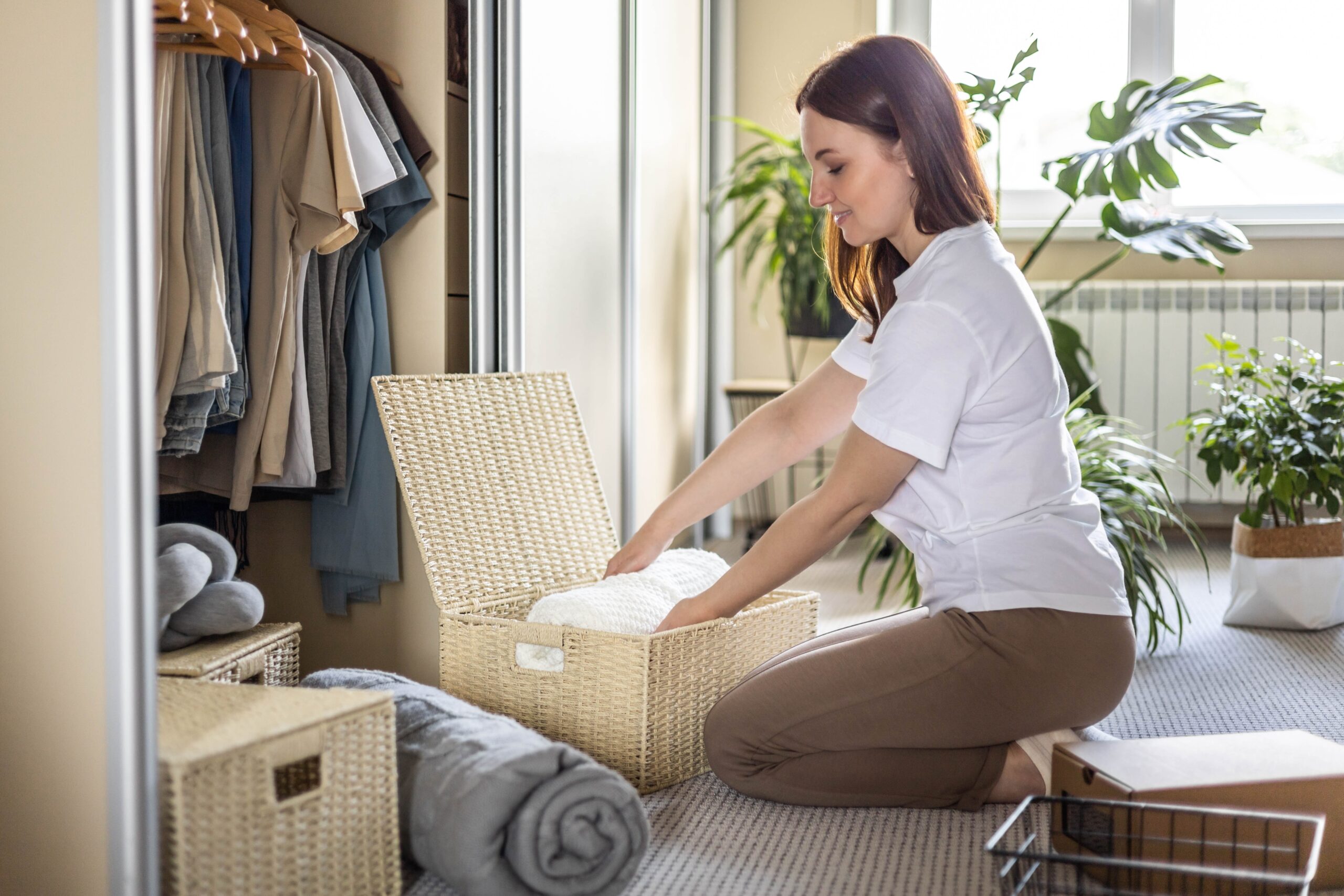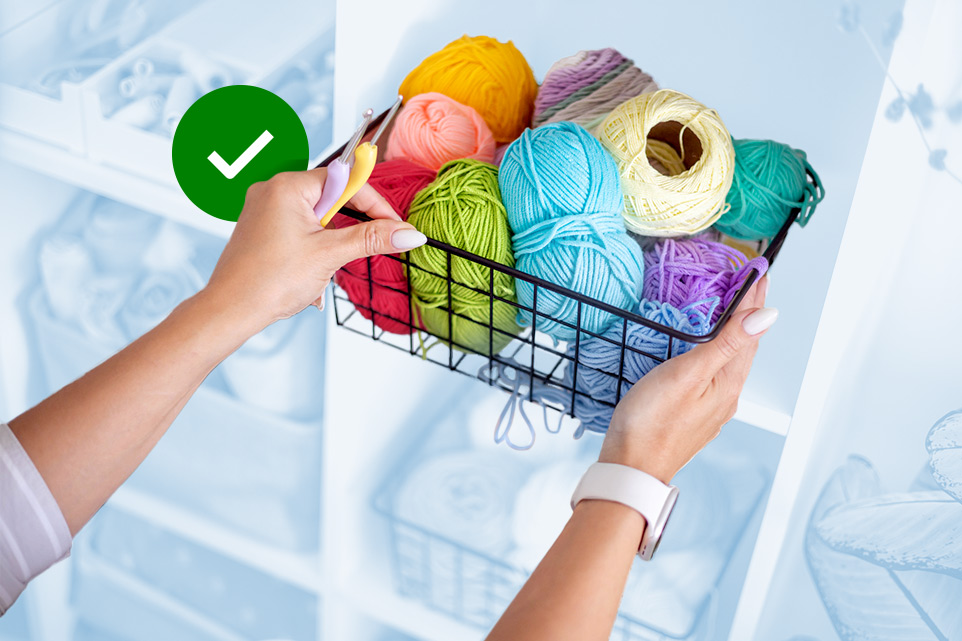If I had to take a guess, the mere thought of organizing long-term storage sends shivers down your spine, and not the thrilling kind. Much more than just shoving items into a dark storage locker and hoping for the best, preparing your belongings for long-term storage is a tightrope walk between care and neglect.
You might be asking yourself, “What is considered long-term storage?” Long-term storage is when you store a vehicle or moving boxes and storage containers full of your belongings, clothes, and knick-knacks, in a basement, attic, garage, or storage unit for any time period longer than three months.
So, despite this topic ranking pretty low on the thrill spectrum, long-term self-storage and long-term storage units can be the best option for anyone involved in home renovations, making a big move, or downsizing.
Let’s dive headfirst into the place where prized possessions mingle with dust bunnies. This practical guide will teach you how to pack for long-term storage. We’ll cover the most important long-term storage packing tips.
Finally, we’ll reveal how to use Self-Storage.com’s signature search tool to find the ideal storage unit features and unit size to keep your specific items safe for the long run.
Packing For Long Term Storage – Key Takeaways

- Declutter and Deep Clean: Start by purging items you no longer need, such as impulse buys, and thoroughly cleaning everything that’s going into storage.
- Special Care for Fragile Items: Take extra precautions for items like mattresses, furniture, electronics, and collections by disassembling, wrapping, and considering climate-controlled storage.
- Proper Packing Materials: Use sturdy, translucent, and breathable plastic boxes, bubble wrap, acid-free tissue paper, and furniture covers to protect your belongings.
- Labeling system and Inventory lists: Create a detailed inventory of your items, label bins clearly, and keep a physical copy inside the storage unit.
- Climate-Controlled Storage: Invest in climate-controlled units for sensitive items like wooden furniture, electronics, artwork, and collections.
- Elevation and Organization: Stack items from heaviest to lightest, use shelves or pallets, and keep frequently accessed items at the front.
- Regular unit check-ins: Schedule routine check-ups to monitor the condition of your stored belongings and address any issues.
Declutter and Deep Clean
Up first, the grand pre-storage cleaning ritual! Decluttering prior to storing allows you to pay for only the space you need, rather than stuffing your storage unit full with stuff you no longer want. After a thorough purge, it’s time to clean … everything!
Vacuum, dust, polish, de-grime, or launder anything and everything that’s headed in. After all, there’s no use employing dust protection on items that haven’t been dusted off in the first place!
Some ‘special stuff’ considerations:
- Vacuum mattresses to remove dust and debris, and spot clean any stains with a mild detergent. Allow it to dry completely, then put it in a properly sized protective covering that will prevent moisture damage and potential mold growth. Prevent sagging and drooping by storing flat.
- Disassemble large furniture items, like beds, tables, shelving units, baby items like cribs, and remember to keep assembly hardware nearby in labeled plastic bags or containers. This step will help you save space and prevent damage.
- Dust and polish any wooden furnishings to maintain luster and protect them from drying and warping. Wrap them in breathable moving blankets to prevent damage.
- With a soft, dry cloth, dust all electronics and properly label and store any cords, cables, and accessories to prevent tangling and future frustration.
- To protect vinyl records, canvas paintings, instruments, wedding keepsakes, and any other prized collections from the harmful effects of extreme hot or cold temperature levels, learn about climate-controlled storage units.
Once you’ve cleaned and properly prepared all your goodies for storage, you’ll also need to clean the unit and remove any potential hazards. Pull out the shop vac and get to work on the floors, wiping down surfaces and checking for any signs of pests or moisture.
You’ll want to take advantage of pest deterrents to prevent infestations proactively. Once pests settle in, you have to bring in a pest control company, and that might mean cleaning your belnigngs all over again to free them from chemical residue.
Moisture-absorbing products like silica gel desiccant packets or dehumidifiers can help maintain optimal conditions by preventing mold, mildew, and excess moisture.
Proper Packing Materials
After cleaning and organizing, packing with a purpose is the next step in prepping for long-term storage. It’s time to play Goldilocks with your containers: not too big or too small, but just right.
Plastic bins are preferable to strong cardboard moving boxes in many cases because they can stand the test of time, offer better protection from pests and moisture, and they’re stackable, too. Choosing translucent plastic bins gives you an added superpower, allowing you to see what you’re after with ease.
Further protect your items by making sure containers are spotless, bone dry, and free from any lingering odors prior to packing. Superior packaging materials are our next requirement. Employ it all: bubble wrap, acid-free paper, packing paper or “archive paper,” foam padding, and furniture covers.
Give your fragile glassware, ceramics, and sensitive tech items extra TLC by wrapping them individually with bubble wrap or acid-free paper and layering them in bins with extra padding. If you have a lot of books heading into long-term storage, turn to this book-specific guide to protect their spines, and yours!
Labeling and Inventory
Now it’s time to talk about a labeling system for you storage inventory. We’ll want to label our bins and boxes for the long haul.
Be careful not to fill your bins right up to the brim so they’ll still create a good seal around the edges of the lid. If you’ve opted for cardboard boxes, grab that packing tape and go to town, adding extra layers of packing tape to the bottom and seams for extra strength.
Now, onto the labeling game (and trust me, this part is a lifesaver). Before you put anything into long-term storage, take the time to complete a thorough inventory of all your belongings. The reselling, small business and prepper communities on YouTube showcase some awesome ideas for inventory systems, including some that have item photos corresponding to specific numbered bins.
If you’ve got the time, it will be well worth finding one that jives with you. Make sure you have a physical copy of your inventory system in addition to the digital one. Go ahead and secure a physical copy within the storage unit itself for easy access. When you’re hunting for that one treasure, no other map compares.
Climate-Controlled Storage
You have a few options when it comes to self-storage: using space in your or someone else’s house (attic, basement, shed, etc.), renting a traditional unit, or investing in a climate-controlled unit: the VIP section of the self-storage industry.
These bad boys shield your belongings from extreme temperatures and humidity, reducing the likelihood of bug infestations and mold growth. As previously mentioned, everything that’s susceptible to the whims of Mother Nature, like wooden furniture, electronics, artwork, and so on, is an ideal candidate for climate control.
Thinking the cost of VIP isn’t justified? Well, I’ll offer up a cautionary tale. In a fit of frugality, I decided to stash my very comfy (and very pricey) couch in my friend’s attic to save a few bucks on storage fees. “It’ll be fine,” I said, “what could possibly go wrong?”
Unfortunately, I didn’t factor in that the deal came with a heavy rain + leaky roof combo, and when the time came, I collected a sad and soggy couch. Let’s just say, investing in a proper storage space would’ve saved me much more than the cost of a new couch. Sometimes it does pay to pony up.
Pro Tip: If you’re weighing your options, this quick look at 24-hour storage amenities can help you choose a facility that fits your needs—especially if accessibility or flexibility is a must.
Elevation and Organization
To maximize protection and keep everything secure from unforeseen leaks or spills, elevating your belongings using palettes or platforms is a must. Channel your inner Tetris master, stacking items upward from heaviest to lightest. Garage shelves are a good option for strong shelving units. They’ll allow you to make the most of the vertical space, and can be used to create rows for easy accessibility. If you think you’ll be heading into your unit to find specific items at any time, leave yourself ample space to get at it!
In fact, go one step further by making sure the front of the unit is where you keep the things you’ll use most often. This could be anything from garment bags full of seasonal clothing and holiday decor, to your camping or sports gear. Avoid future hassles by taking a minute to think through how you plan to use your long-term storage to organize it for efficiency.
Regular Check-ups
Just like your annual physical, your stored items need regular check-ups too. Set a reminder on your phone, mark it on your calendar, or use whatever memory tool works best for you. During these routine check-ups, give your space a once-over, making sure everything is in good condition. Doing so will keep you one step ahead of any mold, critter, or sticky situation.
How SelfStorage.com Can Help With Long-Term Storage
Now that I’ve taken you from the daunting prospect of long-term storage all the way to becoming seasoned stuff strategists, you’ll be scrubbing, packing, labeling, and organizing your way to storage success.
Just keep in mind that it’s not a “set it and forget it” situation when you say goodbye to your possessions and put them in their new temporary home. Remember to check in on your long-term storage unit from time to time for the sake of a smooth reunion.
But all this hard work prepping and packing for long-term storage can be wasted if the storage room itself isn’t up to the task of protecting your belongings.
We don’t all have a spare room or extra walk-in closet we can dedicate to long-term storage, especially considering all the effort you put into preventing pests, moisture buildup, mold, and mildew.
But don’t fret–SelfStorage.com is here to help.
If your storing temperature-sensitive items vulnerable to moisture damage, like furniture, art and canvas paintings, vinyl records, or documents, susceptible to a small, climate-controlled storage unit.
A climate-controlled self-storage unit creates the ideal environment, protecting your belongings against pests, moisture, corrosion, and the dramatic temperature changes that can cause damage to wood, paper, and even cotton.
But not all storage units are created equal. Some aren’t climate-controlled, and others add amenities such as security cameras or 24-hour access.
Storage units also come in various sizes, with the smaller storage unit sizes being quite affordable. Plus, if you’re still deciding between short-term vs long-term storage, most storage facilities have short-term leases, sometimes even month-to-month.
SelfStorage.com can help you select the ideal storage space. Just punch your zip code into our handy storage search tool to find a storage unit between your house and work so you don’t have to go out of the way to grab stuff you need from your long-term storage solution.
Our site searches through over 20,000 storage facilities nationwide. The search tool lets you filter your results based on the search parameters you set. Narrow your results based on location and amenities, such as climate control and 24-hour access.
SelfStorage.com lets you compare prices and unit sizes and reserve your storage unit for free in minutes. No commitment and no credit card required!







